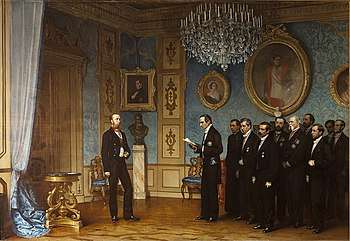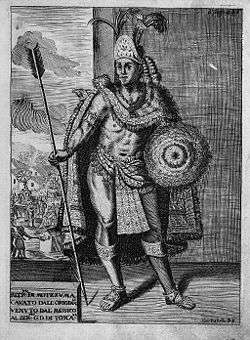Mexican nobility
The Mexican nobility includes elite indigenous families from the pre-Columbian era; indigenous elites recognized as nobles in the colonial era (1521–1821); and hereditary nobles and economic elites who acquired noble titles in the colonial era; and the First Mexican Empire (1821–23), immediately after independence from Spain, and the Second Mexican Empire (1862–67). While some titles were granted in Mexico itself, other families brought with them their old titles from Europe.

The Political Constitution of Mexico has prohibited the state from granting any titles of nobility since 1917. The United Mexican States do not issue or recognize titles of nobility or hereditary prerogatives and honors.
Indigenous nobility

The Aztecs and other Indigenous peoples in Mexico had a system of hereditary aristocracy in place when the Spanish arrived in Mexico. The Spaniards respected this system and added to it, resulting in many unions between Aztec and Spanish nobility. Descendants of the elites of pre-Columbian Mexico who received these distinctions included the heirs of the Aztec ruler Moctezuma II; That family became known as the Condes de Moctezuma, and later, the Duques of Moctezuma de Tultengo. The holders of the title, who still reside in Spain, became part of the Spanish nobility in 1766 when they received a grandeza. A branch of their family, on the female side, continued to receive an annual payment from the Mexican government in the amount of some 500 gold ducats until 1938, as part of a contract signed in the 16th century granting Mexico City access to water and lumber on family property.
Some families of pure Amerindian ancestry, such as the Mixtec Villagómez family, were among the richest landowners in New Spain after the conquest of the Aztec empire. Despite being part of the colonial elite after the conquest, the Villagómez retained their Mixtec identity, speaking the Mixtec language and keeping a collection of Mixtec codices.
Numerous other Indigenous elites collaborated with the conquest, earning noble titles and privileges. Most notably, all the Tlaxcallans, who resettled into northern Mexico, became hidalgos.
Titles in Viceregal Mexico and the First Mexican Empire
Families who received a título de Castilla during the colonial period were the first to be granted European noble titles in New Spain (Mexico). One of the first was the Spanish noble Conquistador Hernán Cortés, who was granted the title of Marqués del Valle de Oaxaca. Cortés's first wife was Doña Catalina Marcaida Jaurez, and the marriage was an important political alliance while he was in Cuba. His second marriage was to a noblewoman. Approximately 130 titles were held by Spaniards born or resident in New Spain. Main centers of population included Mexico City, Puebla, Querétaro, San Miguel de Allende, Guanajuato, Guadalajara, and Morelia (Valladolid).
The largest number of noble titles were created in the eighteenth century under the Spanish Bourbon monarchs and the influx of foreign nobles to Mexico. Leading noble families active in 17th, 18th, and 19th century politics, economy, clergy, arts and culture included:
- De la LLamosa, Gómez de Cervantes, Romero de Terreros, de la Cámara or Cámara, Rincón-Gallardo, Romay, Riverol, Pérez Gálvez, Rul, Vivanco, La Canal, Cañedo, Fernández de Jáuregui, Obando, Fernández de Córdoba, Gómez de Parada, Lara, Lorenz de Rada, Pérez de Salazar, Ruiz de Velasco, Valdivieso, De Haro y Tamariz, Fagoaga, Echeverz, Dávalos de Bracamonte, Peón, Gutiérrez-Altamirano, Castañiza, Gómez de la Cortina, Urrutia, Velasco, Moncada, Diez de Sollano, de Busto y Moya, Reynoso y Manso de Zúñiga, Capetillo, de la Parra, Villaseñor-Cervantes, Villaseñor-Jasso, López de Zárate, Camino, Caserta, Trebuesto, Ruiz de Esparza, García de Teruel, Espinosa de los Monteros, Vizcarra, Rábago, Sardaneta, Martínez del Río, Ozta, Azcárate y Ledesma, de la Torre Ledesma, Molina Flores, Vera Martinez y Cazarez, Samaniego del Castillo, Lemus, Mier, De la Maza, González de Betolaza, López de Peralta, Padilla, Diez-Gutiérrez, Flores-Alatorre, Cosío, Rivadeneyra, de la Cotera, de la Campa y Cos, Rodríguez Sáenz de Pedroso, Padilla, Rivascacho, Villar-Villamil, Rodríguez Rico, Sánchez de Tagle, Báez de Benavides, Cabrero, Hurtado de Mendoza, López-Portillo, García Pimentel, Meade, Sánchez-Saráchaga, Sainz Trápaga, Villaurrutia, Errazu, Escandón, Heredia de la Pierre, Quintanar, Beovide, Alvarez de Medina, Sánchez de Aldana, Yermo, de Yturbe, de Béistegui, de Rivera, Zubaran-Capmany and Sánchez-Navarro, among others.[1]
At independence, a few princely dignities were accorded the Imperial family's relations and three titles of nobility — the latter already under application with the Spanish government — were recognized by the Congress of the First Mexican Empire, such as the Marqués de Samaniego del Castillo. Knighthoods were also created, most notably, of Guadalupe. Throughout the 19th century others received pontifical titles of nobility, and through loopholes in Spanish law, had these titles recognized as títulos de Castilla; these are known as títulos negros and include the titles of the marqués de Barrón, conde de Subervielle, conde del Valle (Fernández del Valle family), duquesa de Mier, and others. Many of these families were part of the hidalgo class. Some families, after Mexican Independence, received títulos de Castilla from the Spanish monarch directly, such as the duque de Regla and the duquesa de Prim, or indirectly, through marriage to individuals holding these titles, such as the duque de Castroterreño or the Escandón family members who subsequently became duques de Montellano, marqueses de Villavieja.

After the fall of the First Empire, the imperial family resided in Italy, and later, in the United States. Afterwards, the Second Mexican Empire, under Maximilian I of Mexico of the House of Habsburg, re-established knightly orders. It granted no new titles of nobility.
List of titles of nobility in Mexico
- Marqués del Valle de Oaxaca (1529); Hernán Cortés and descendants
- Marqués de Salinas de Río Pisuerga (1609); Altamirano de Velasco, Cervantes
- Conde de Santiago de Calimaya (1616); Altamirano de Velasco, Cervantes
- Marqués de Villamayor de las Ibernías (1617); Pacheco
- Conde de Valle de Orizaba (1627); Rincón Gallardo
- Conde de Moctezuma (1627) G.E.; Moctezuma de la Cueva
- Marqués de San Miguel de Aguayo (1683); Echevers
- Conde de Miraflores (1689); Garrastegui
- Marqués de la Villa de Villar del Águila (1689); Urrutia
- Conde de Miravalle (1690); Dávalos Bracamonte
- Marqués de Santa Fe de Guardiola (1691); Padilla, López de Peralta, Cervantes
- Marqués de Altamira (1704); Sánchez de Tagle
- Marqués de las Torres de Rada (1704); Lorenz de Rada[2]
- Marqués de Sierra Nevada (1708) ; Ruiz de Tagle
- Marqués de Salvatierra (1708); Cervantes
- Duque de Atrisco (1708); G.E.; Sarmiento, Romay-Sotomayor
- Conde de Ledesma de la Fuente (1710)′
- Marqués de Villa Hermosa de Alfaro (1711); Rincón-Gallardo
- Conde de San Mateo de Valparaíso (1727); Landa y Escandón
- Marqués de Acapulco (1728); de la Cerda
- Marqués de San Clemente (1730); Busto
- Marqués de las Salinas (1733); Pérez de Tagle
- Conde de Revillagigedo (1749); Revillagigedo
- Marqués de Rivascacho (1764); Cervantes
- Conde de Regla (1768); Romero de Terreros, Rincón Gallardo
- Marqués del Apartado (1772); Fagoaga, Campero
- Conde de la Presa de Jalpa (1775); Cervantes
- Marqués de San Cristóbal (1777); Romero de Terreros, Rincón Gallardo
- Marqués de San Francisco (1777); Romero de Terreros
- Marques del Bajio (1798); Count Siles-Villegas and descendants
- Conde de Pérez Gálvez (1805); Pérez-Gálvez
- Marqués de Guadalupe Gallardo (1810); Rincón-Gallardo
- Marqués de Yermo (1810); Gabriel de Yermo and descendants (with the right to choose denomination)
- Conde de Heras-Soto (1811); Heras Soto, García Pimentel
Modern period
During the Porfiriato, members of the Mexican aristocracy were very active in politics. Prince Agustín de Iturbide y Green, Maximilian's adopted son, who had graduated from Georgetown University, renounced his claim to the throne and title. Iturbide returned to Mexico and served as an officer in the Mexican army. But in 1890, after publishing articles critical of President Porfirio Díaz, he was arrested on charges of sedition and sentenced to fourteen months of imprisonment.[3] He returned to Georgetown University, as a professor of the Spanish and French languages, and died in 1925.
Members of the Rincón Gallardo, Romay-Basail, Fagoaga and Pimentel families (marqués de Guadalupe, señor de Cadro y Monterroso, marqués del Apartado and conde de Heras Soto) were active in Mexico City government, the ministry of Foreign Affairs, the Senate, the armed forces, and the Academia de la Lengua or the Sociedad de Geografía e Historia. Many journeyed and lived abroad, often doing so in Paris, London, and Madrid. Most men studied at British public schools. By marriage into such French families as the Polignacs and de Villeneuves, a number of persons of Mexican descent were noble.
At the beginning of the 20th century, the Mexican nobility — both titled and untitled — consisted of approximately 1.5% of Mexico's population, or approximately 200,000 people.[4]
Current legal status
The Political Constitution of Mexico expressly prohibits the state from recognizing (or granting) any titles of nobility since 1917. Mexicans are also prohibited from accepting foreign distinctions without permission from the Congress of the Union.[5]
See also
Notes
- Doris M. Ladd, The Mexican Nobility at Independence, 1780–1826, Appendix.
- "MINISTERIO DE EDUCACIÓN, CULTURA Y DEPORTE - Portal de Archivos Españoles". pares.mcu.es (in Spanish). Retrieved 2017-02-20.
- "Prince Augustin Yturbide: Most of His Life Spent in Washington", The New York Times, 4 May 1890
- Nutini, The Wages of Conquest, 183-189.
- "ARTICLE 12 – The United Mexican States do not grant titles of nobility or hereditary prerogatives and honors, nor give effect to those provided by any other country." Taken from the current official text at "Archived copy" (PDF). Archived from the original (PDF) on 2013-01-02. Retrieved 2012-12-23.CS1 maint: archived copy as title (link)
External links
- Lopez De La Cadena, Alberto Homero, https://web.archive.org/web/20090413013353/http://www.cryptojews.com/Our_Secret_Heritage.htm
- Macias-González, Victor M. "The Mexican Aristocracy in the Porfirian Foreign Service." Book Manuscript Summary
